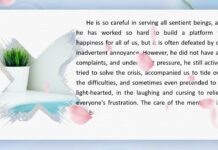–Volume 1 (Part 5)
Author: Fafu
Translator : Lotus
Dear Dharma friends, Hello everyone. Welcome to this episode of the podcast contributed by the Buddhas’ Practice Incorporated of Australia.
Today, let us together explore the two fundamentals. The Buddha’s teachings reveal the key to the cycle of birth and death and the attainment of supreme enlightenment. I hope that through today’s sharing, we can more clearly discern truth from delusion.
1. Ananda’s Request for the Dharma
The story begins with Venerable Ananda’s request for the Dharma. He deeply repented, feeling pained that despite his vast learning and knowledge, he had not attained the state of purity free from defilements. Thus, during the Dharma assembly, he respectfully asked the Buddha to expound on the path of Samatha—the true path leading to meditative concentration and ultimate Buddhahood. He also hoped that the Buddha’s teachings would help those lacking faith to dispel their doubts and rekindle their wholesome roots.
Upon hearing this earnest request for the Dharma, the Buddha immediately emitted boundless light from his face, like the radiance of a hundred thousand suns, illuminating the infinite worlds in all ten directions. The lands of all Buddhas appeared simultaneously, and all bodhisattvas, arhats, and sentient beings joined their palms to listen to the Buddha’s teachings. This scene demonstrated the Buddha’s boundless majesty and signified that this discourse was a universal salvation for sentient beings in all ten directions, bearing profound significance.
2. The Two Fundamentals
The Buddha directly pointed out that since beginningless time, all sentient beings, due to inverted delusions and false thinking, have created various karmic causes, cycling endlessly like a cluster of fruit on a ruksa tree, leading to their inability to attain supreme enlightenment. Even the fruits of the Sravaka or Pratyekabuddha or the realms of the heavenly kings and demons of other teachings, are led astray because they do not understand the fundamentals. The Buddha used the analogy that such erroneous practices are like trying to cook sand to make delicious food—no matter how many eons pass, it will never succeed. Why? Because they do not know the two fundamentals and thus engage in confused cultivation.
So, what are these two fundamentals?
The Root of Birth and Death
The first fundamental is the beginningless root of birth and death, which is that sentient beings seize upon conditions mind as their own true nature. What is the conditioned mind? It is the mind full of rampant delusions and chaotic thoughts. ” Seize ” refers to grasping and not letting go; “conditions” refer to relying on past experiences, perceptions, and feelings, combined with greed, anger, ignorance, arrogance, and doubt, to weave endless delusions.
Sentient beings mistakenly regard this conditioned mind as their true self, constantly chasing and attaching to phenomena, unaware that this is precisely the root of the cycle of birth and death. As the Buddha said, the conditioned mind causes us to wander unjustly through the six realms of samsara.
The Root of Nirvana
The second fundamental is the beginningless root of Bodhi and Nirvana, which is our inherent pure true mind. This true mind is the essence of spiritual awareness, neither arising nor ceasing, pure, perfect, undefiled, and untainted. The Buddha described it as the “original understanding, the real nature of consciousness “—this “seeing” is the fundamental source that illuminates all things with perfect clarity. It is inherently endowed with radiance, capable of giving rise to all conditions, yet remains unmoved by those conditions.
However, since beginningless time, sentient beings have relied on this pure “seeing” to give rise to memory and consciousness, thereby clinging to external conditions and chasing delusions. And yet it is among those phenomena that beings lose track of it, they “neglect what is inherent,” overlooking their original true mind. It is like watching a TV drama, getting caught up in joy, anger, sorrow, or delight over the illusory images on the screen, while forgetting that the screen itself is merely a piece of glass. Our true mind is the same: it cannot be grasped, nor can it be abandoned; yet, by chasing illusory phenomena, we neglect awareness of it.
3. The Sorrow of Unawareness
The Buddha lamented that sentient beings, though they use this marvelous true mind every day, with seeing, hearing, and knowing ever-present, remain unaware of it. Everything we see and hear daily is a manifestation of the true mind’s radiant clarity, yet we cling to phenomena, drifting with karma and ceaselessly creating actions. It is like a person holding a priceless treasure while begging everywhere, unaware that they are already abundantly wealthy.
This state of “acting all day without awareness” causes us to suffer in the cycle of birth and death. The deluded mind is the root of birth and death, while the true mind is the root of Bodhi and Nirvana. If we cannot distinguish between these two, our practice will be like trying to cook sand into rice—never leading to accomplishment.
So, how can one recognize the true mind and attain supreme enlightenment? Discerning Truth from Delusion: Understand that the conditioned mind is illusory, while the true mind is inherently present.
4. Conclusion
Dear Dharma friends, the Buddha’s teachings are like nectar poured upon us. Each of us inherently possesses Buddha-nature, with spiritual awareness and clarity never far away. It is only due to a single moment of ignorance, chasing illusory phenomena, that we wrongly fall into the cycle of samsara. May all sentient beings dispel their doubts, rekindle their wholesome roots, and together attain Nirvana!
Thank you all for listening!





